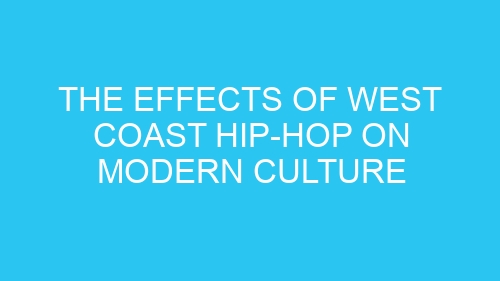-
Table of Contents
The Influence of West Coast Hip-Hop Fashion Trends on Modern Style
West Coast hip-hop has undeniably left an indelible mark on modern culture. From its infectious beats to its thought-provoking lyrics, this genre has captivated audiences worldwide. But it’s not just the music that has had a lasting impact. West Coast hip-hop fashion trends have also played a significant role in shaping modern style. So, let’s take a closer look at how this influential genre has influenced the way we dress.
One of the most iconic fashion trends to emerge from West Coast hip-hop is the baggy pants phenomenon. Back in the day, artists like Snoop Dogg and Tupac Shakur were often seen sporting oversized jeans that seemed to defy gravity. These pants were so loose that they practically had a life of their own, swaying with every step. And let’s not forget the sagging trend, where pants were worn so low that it became a challenge to keep them from falling off. It was a fashion statement that screamed rebellion and nonconformity.
But it wasn’t just the pants that made a statement. West Coast hip-hop fashion also popularized the oversized t-shirt look. Artists like Dr. Dre and Ice Cube were often seen rocking t-shirts that seemed two sizes too big. It was as if they were saying, “I’m so cool, I don’t need to wear clothes that fit me properly.” And the rest of the world followed suit, embracing the baggy t-shirt trend with open arms. Suddenly, everyone wanted to look like they had just stepped out of a music video.
Of course, no discussion of West Coast hip-hop fashion would be complete without mentioning the iconic bandana. This humble piece of cloth became a symbol of gang affiliation and street credibility. Artists like Eazy-E and Ice-T would often be seen wearing bandanas as a way to represent their roots and pay homage to their neighborhoods. And soon enough, people from all walks of life were sporting bandanas, whether they had any connection to the streets or not. It was a fashion trend that transcended boundaries and brought people together in a strange, bandana-wearing brotherhood.
But it’s not just the baggy pants, oversized t-shirts, and bandanas that have influenced modern style. West Coast hip-hop fashion has also had a significant impact on sneaker culture. Artists like N.W.A and Kendrick Lamar were often seen rocking the latest and greatest kicks, turning sneakers into a status symbol. Suddenly, it wasn’t enough to have a comfortable pair of shoes; they had to be stylish and coveted. Sneakerheads around the world started collecting limited-edition releases and waiting in line for hours just to get their hands on the hottest kicks. It was a trend that took the world by storm and continues to thrive to this day.
In conclusion, West Coast hip-hop fashion trends have had a profound influence on modern style. From the baggy pants and oversized t-shirts to the bandanas and sneakers, this genre has shaped the way we dress and express ourselves. It’s a testament to the power of music and its ability to transcend boundaries and inspire change. So, the next time you put on a pair of baggy pants or rock an oversized t-shirt, remember that you’re paying homage to the West Coast hip-hop pioneers who paved the way for your style choices. And who knows, maybe one day, your fashion choices will inspire the next generation of trendsetters.
The Impact of West Coast Hip-Hop Lyrics on Contemporary Music
West Coast hip-hop has undeniably left an indelible mark on modern culture. From its inception in the 1980s to its current influence on contemporary music, this genre has shaped the way we listen, dance, and even dress. One of the most significant aspects of West Coast hip-hop is its lyrics, which have had a profound impact on the evolution of music as we know it today.
Let’s take a moment to appreciate the lyrical genius that has emerged from the West Coast. From the gritty streets of Compton to the sunny beaches of Los Angeles, West Coast rappers have never been shy about expressing their thoughts and experiences through their music. Their lyrics are raw, honest, and often laced with a healthy dose of humor.
One of the most notable effects of West Coast hip-hop lyrics on contemporary music is the emphasis on storytelling. Unlike some other genres where lyrics can be vague or abstract, West Coast rappers have a knack for painting vivid pictures with their words. They take us on a journey through their neighborhoods, introducing us to their friends, enemies, and the struggles they face on a daily basis.
Take, for example, the legendary Dr. Dre. In his iconic track “Nuthin’ but a ‘G’ Thang,” he effortlessly transports us to the streets of Long Beach, California. With his smooth flow and witty wordplay, Dre invites us to join him on a laid-back ride through his neighborhood, where the sun is shining, and the party never stops. It’s like we’re right there with him, sipping on gin and juice, and soaking up the West Coast vibes.
Another effect of West Coast hip-hop lyrics is their influence on the language and slang used in contemporary music. West Coast rappers have a way of creating their own lexicon, filled with words and phrases that have become part of our everyday vocabulary. Who hasn’t dropped a “fo’ shizzle” or referred to their friends as “homies” at least once in their life?
Snoop Dogg, the self-proclaimed “Doggfather” of West Coast hip-hop, is a master of this linguistic art. His laid-back delivery and unique word choices have made him a cultural icon. Whether he’s rapping about his love for chronic or his disdain for the police, Snoop’s lyrics have a way of sticking with you. It’s no wonder that his influence can be heard in the music of countless artists today.
Lastly, West Coast hip-hop lyrics have had a profound impact on the way we perceive and discuss social issues. From the early days of N.W.A. to the politically charged tracks of Kendrick Lamar, West Coast rappers have never shied away from addressing the injustices they see in their communities. Their lyrics serve as a powerful tool for raising awareness and sparking conversations about topics such as police brutality, racism, and inequality.
In conclusion, the impact of West Coast hip-hop lyrics on contemporary music cannot be overstated. From their storytelling prowess to their influence on language and social discourse, West Coast rappers have shaped the way we listen to and engage with music. So the next time you find yourself nodding your head to a West Coast banger, take a moment to appreciate the lyrical genius behind it. And remember, it’s not just music – it’s a cultural movement.
The Evolution of West Coast Hip-Hop Dance Moves and Their Cultural Significance
West Coast hip-hop has undeniably left an indelible mark on modern culture. From its inception in the 1980s to its current influence on music, fashion, and dance, West Coast hip-hop has shaped the way we move and groove. In this section, we will explore the evolution of West Coast hip-hop dance moves and their cultural significance. So, grab your dancing shoes and let’s dive in!
When it comes to West Coast hip-hop dance moves, one cannot ignore the iconic “Crip Walk.” This dance move originated in the early 1970s as a way for gang members to communicate and show their affiliation. However, it quickly transcended its gang roots and became a popular dance move in the hip-hop community. The Crip Walk involves a series of intricate footwork and body movements that require both skill and style. It has become synonymous with West Coast hip-hop and has been featured in countless music videos and performances.
Another dance move that has become synonymous with West Coast hip-hop is the “Hyphy.” This energetic and exuberant dance style originated in the Bay Area in the early 2000s and quickly gained popularity throughout the West Coast. The Hyphy dance involves a combination of fast-paced footwork, wild arm movements, and a whole lot of energy. It perfectly captures the carefree and rebellious spirit of West Coast hip-hop and has become a staple at parties and clubs.
But West Coast hip-hop dance moves aren’t just about flashy footwork and wild arm movements. They also have a deeper cultural significance. Take, for example, the “Turfing” dance style. Turfing, short for “Taking Up Room on the Floor,” originated in Oakland and is a form of street dance that tells a story. It combines elements of popping, locking, and waving with storytelling and improvisation. Turfing is not just about the dance moves; it’s about expressing oneself and sharing one’s experiences through movement. It has become a way for communities to come together and celebrate their culture and heritage.
In addition to the dance moves themselves, West Coast hip-hop has also influenced the fashion world. The baggy jeans, oversized t-shirts, and bandanas that were popularized by West Coast rappers have become iconic symbols of hip-hop culture. These fashion choices were not just about style; they were a way for artists to express their identity and represent their communities. Today, you can still see the influence of West Coast hip-hop fashion in streetwear and urban fashion trends.
So, what is it about West Coast hip-hop dance moves that make them so influential? Perhaps it’s the combination of skill, style, and storytelling that sets them apart. Or maybe it’s the way they capture the spirit of rebellion and self-expression. Whatever the reason, West Coast hip-hop dance moves have become an integral part of modern culture.
In conclusion, the evolution of West Coast hip-hop dance moves has had a profound impact on modern culture. From the iconic Crip Walk to the energetic Hyphy and the storytelling Turfing, these dance styles have not only entertained us but also provided a platform for self-expression and cultural celebration. So, the next time you find yourself on the dance floor, remember to pay homage to the West Coast hip-hop pioneers who paved the way for the moves we love today. Keep grooving, keep moving, and keep the West Coast spirit alive!

